|
KIT: |
Hasegawa 1/48
P-47D 'Razorback' |
|
KIT # |
9058 (JT 58) 'South
Pacific Theater' |
|
PRICE: |
$31.95 |
|
DECALS: |
Two aircraft:
348th FG a/c 'Darling Dottie III' and 'Fiery Ginger' |
|
REVIEW &
PHOTOS : |
Paul Mahoney
|
|
NOTES: |
Aeromaster decals and True Details seat used
|
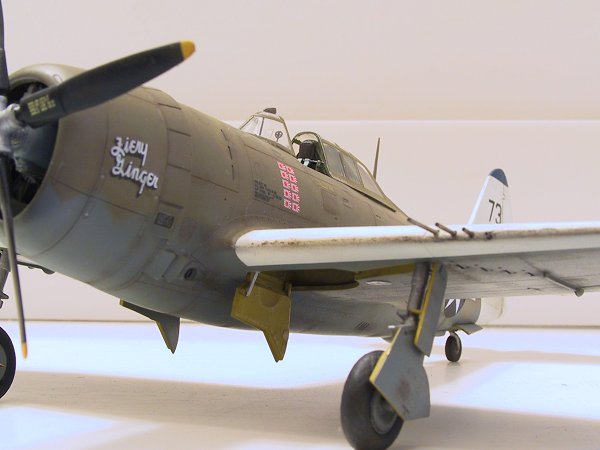
Neel Kearby was the Commander of the 348th Fighter Group, having been
in the Army Air Forces (Army Air Corps at the time) since 1937. In May 1943
Kearby brought the Group with it's P-47s to Port Moresby, New Guinea.
General consensus at the time was that the P-47 was ill-equipped for combat in
the Pacific. It was a big, heavy airplane designed for high-altitude combat
over Europe. Most of the fighting in the Pacific took place at lower altitude
with the small, nimble Japanese aircraft. The P-47 was often considered too
ungainly for combat with the heavy German fighters of the time, let alone the
maneuverable Japanese ones. In addition, the limited range of the P-47 would
be a tremendous hindrance in the vast distances of the Pacific theater.
Official U.S. policy at the time gave priority to the war in Europe, and that
priority extended to equipment. Thus, commanders in the Pacific took anything
they could, regardless of suitability. The Commander of the Fifth Air Force
(located in the South Pacific), General Kenney, was well-known for his
willingness to improvise and do the best possible with whatever he could get
his hands on.
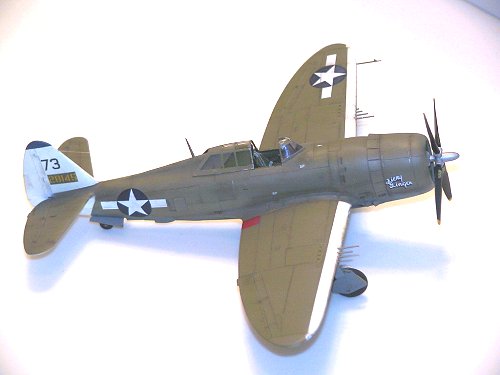
One major problem with the 'priority' situation, was that most additional fuel
drop tanks went to Europe, in spite of the greater distance problems in the
Pacific. Kenney's improvisational skills filtered down through the ranks, and
in Brisbane, Australia USAAF repair squadrons developed their own belly tank
capable of carrying 200 extra gallons of fuel. As a note here - this tank is
decidedly different than the tanks carried in Europe, and Hasegawa only
provides the European 'standard' tank in it's kits. So this is unusable for
most Pacific-flown P-47s.
The range problem now somewhat solved, the issue of the massive
size/weight/bulk of the P-47 came to the forefront. How could this beast
possibly compete with the aerobatic nimbleness of the Japanese aircraft it was
supposed to be fighting? Many within the USAAF thought a better solution lay
in the P-38 - this aircraft not only had some performance advantages over
Japanese aircraft, but it had two engines and a greater range. These two
factors alone made it a better candidate for the vast stretches of the
Pacific, at least according to many in the Fifth Air Force.
Kearby was a proponent of the P-47 from the outset, convinced it's heavy
armament (8 .50 caliber guns) and performance at altitude could be a
tremendous asset. To convince others, Kearby began his own public relations
campaign for the fighter. There are unconfirmed stories that Kearby squared
off against legendary P-38 ace Richard Bong in a mock dogfight to prove the
worth of the P-47. If the stories are to be believed, the 'battle' ended in a
draw. If nothing else, that story showed others that the P-47 was at least
the P-38's equal.
Kearby devised tactics that would take advantage of the P-47's strengths. His
main tactic was to immediately climb to high altitude on a sortie, around
25,000 feet, and upon seeing enemy a/c (who almost always flew at lower
altitudes), to use the weight and speed of the Thunderbolt to engage in a
high-speed slashing dive, unleashing the massive firepower of it's eight
guns. The high speed would then give the P-47 a chance to regain altitude
after the attack. This technique seemed sound, but because the P-47s rate of
climb (unlike it's ability to dive) was so slow, the 348th Group was confined
to operate in the Port Moresby area, where they were assured at least an
hour's notice of any impending Japanese air activity.
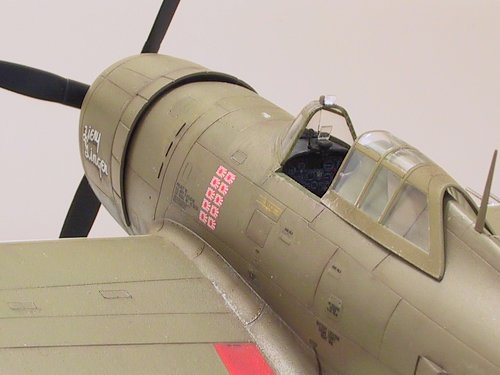
In the first few combat engagements, P-47 pilots attempted to dogfight with
the enemy, and predictably losses were high for the Americans. This
reinforced views of the superiority of the P-38 (or rather the inferiority of
the P-47), but Kearby insisted it was a matter of proper training and
discipline to wring out the better characteristics of the P-47. He continued
on p.r. tours around the region, demonstrating his slashing attack ideas.
Kearby eventually proved his technique, downing his first two Japanese
aircraft on September 4th, 1943. Quickly the tactics were becoming more and
more successful, and by October the group was beginning to shoot down more and
more aircraft, culminating in a historic action on the 11th of that month.
Neel Kearby won the Medal of Honor for his actions in a battle that took place
over Wewak on October 11th, 1943. Kearby took a patrol of four aircraft up,
hoping to draw out some Japanese aircraft and prove his slash and burn tactic
once and for all. As it turned out, a mixed group of approximately 40
aircraft (Ki43s and Ki61s) rose to meet the Americans. Over the course of the
next hour, the greatly outnumbered American pilots managed to shoot down 9
Japanese, without a bit of damage to themselves. Kearby himself scored 6
victories, not only making him an ace, but setting the record for the most
victories by one pilot on a single mission in the Pacific up to that date. As
a result, he became the first USAAF pilot awarded the Medal of Honor.
The resulting hype of this mission set off an unofficial 'Ace Race' between
Kearby and P-38 pilots (specifically Richard Bong) in the Pacific. All
were vying to be the first to top WWI American Ace Eddie Rickenbacker's 26
victory tally. Kearby had a self-imposed goal of 50 victories before stopping
flying, but General Kenney thought him too valuable to leave in combat for
that length of time. He want Kearby training and selling War Bonds. Despite
this, Kearby wanted to stay in the action and continued to fly and chalk up
more victories. Both Kearby and Bong had achieved 21 victories by the
beginning of 1944.
On March 5th of 1944, Bong's score had risen to 24, and Kearby became anxious
that he might lose this race. He planned a mission the very next day designed
to add to his tally. Taking a flight of 3 P-47s once again over the Wewak
area, Kearby spotted a flight of Japanese bombers. The group attacked, and
after the first pass, Kearby violated his own cardinal rules by circling
around to see the results of his work. Kearby always stressed never losing
speed or altitude while in combat, yet entering into a circling turn he did
just that. He succeeded in shooting down a bomber on this second go around,
but lost all speed in doing so, and was pounced upon by a lone Ki43 from
above. No speed meant no maneuverability. His fellow pilots quickly caught
up to the Ki43 and shot it down, but not before the Japanese aircraft had shot
up Kearby's P-47. His aircraft disappeared from the sight of the other two
pilots. Kearby was carried as MIA until 1948. It was later determined that
Kearby did in fact bail out of his stricken aircraft, but died of wounds from
the attack immediately thereafter. The bomber shot down became his 22nd, and
final, victory.
Incidentally, Kearby was probably flying Fiery Ginger IV on his last mission,
while the subject of this build is Fiery Ginger III (although no Roman
numberals were used on his first 3 aircraft).
I picked out this kit to build with the idea of doing a quick and easy one.
As usual, things didn't quite work out that way. Here the fault is all
mine, not Hasegawa's. I had been working on several projects at the time,
including applying brute force to Hobbycraft's Ar234. Well, Hasegawa
announced their impending Ar234 issue, and I decided that was a sign. So
out came the P-47 for an 'easy' build.
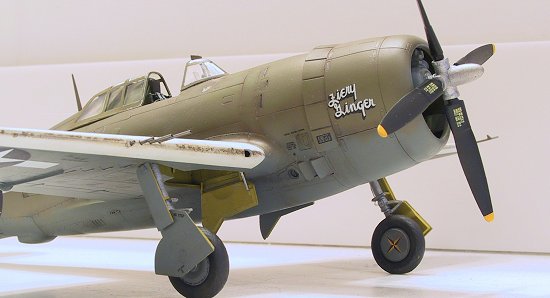
I wanted to build it as Neel Kearby's aircraft, and with that being one of
the kit decal options I thought things would be even easier. I dug out the
references, and of course immediately ran into a few snags. The markings on
Kearby's aircraft evolved over time, and I found various discrepancies in
each of my references. I ran out and bought 'Kearby's Thunderbolt's,'
published by Schiffer, thinking surely my answer will be in here. Wrong. A
few posts on the Hyperscale board resulted in the friendly help of Ed Dixon
- he sent me copies of an article in FSM specifically discussing Kearby's
markings. Unfortunately, once again, contradictions popped up -- even with
another work by the same author (Osprey's Aces book)!!
The main sources of markings contradiction that I found are:
Tail number: blue (same as fintip color) or black?
'Fiery Ginger' writing colors?
Which combination of national markings/victory flags/theater id markings
(white tail) are correct?
I relied on most of the article in FSM to arrive at these markings, with one
major exception. All the profiles of Fiery Ginger I have seen depict the
entire tail surfaces in white, with a swept-forward demarcation line. There
are many in-flight shots of this a/c with just such markings. The problem
is that these are all early photos, showing no victory flags and carrying
the star/circle national markings (no bars). I wanted to show some victory
markings on my aircraft. Aeromaster's sheet includes 12 flags, and displays
this a/c with bars on the national insignia (but with a blue tail number).
Hasegawa's sheet has no bars, fewer flags, and a blue (but different stencil
style) number. The 'Fiery Ginger' name is black and white on the Aeromaster
sheet, and red/yellow in Hasegawa's.
The FSM article suggests the tail number was black, and in most of the
photos there seems to be enough contrast between the numbers and the blue
fin tip to suggest that is true. So issue number one was solved in my mind
- black numbers. This article also has the name in black and white, and I
would agree with this assessment. Several other aircraft from this unit had
names painted in a similar style, and photos I have seen all seem to have a
very high contrast between the colors, which certainly appears more
black/white than red/yellow to me. I'm no photo interpretation expert, but
this seems right to me. Issue two solved (at least in my mind).
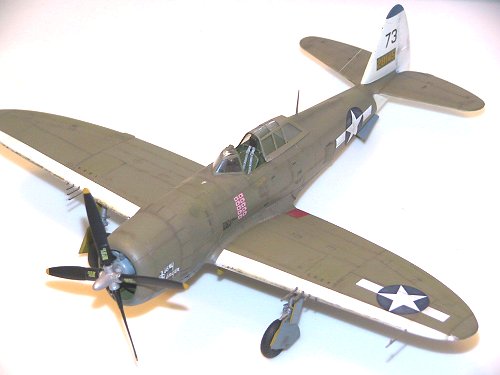
I had almost been ready to use the 'barred' national insignia, combined with
12 victory flags, and a full white tail (as per the Aeromaster sheet which
should have been a warning in and of itself!!). The national insignia/flag
combo had to be right, as Kearby did not score this many victories until
October of 1943. By this time the bar had been on the insignia officially
for several months. So Aeromaster's combination of insignia and victories
was correct, or at least plausible. Hasegawa's might have been correct as
well, but I tend to think the bar was already added to the national markings
by the time any victory markings were applied (Kearby's first victory was
Sep. 4th, 1943). Most of this issue was therefore solved.
One photo I found caused me to question the all-white tail for Kearby's a/c
appearance at this time (late Oct 1943). This photo shows his a/c revving
up on the flightline prior to take off (page 191 of Kearby's Thunderbolts).
It shows a 3/4 view from the front, the bar is on the national insignia, and
very clearly the white tail markings are swept upwards at an angle, BUT
ending at the leading edge of the tailplanes. The white on the vertical
tail surfaces clearly ends at the fuselage join. In other words, there is
olive drab on the fuselage area between the vertical and horizontal tail
surfaces. No other photos show this that I have found. Most of the later
photos unfortunately only show the front sections of this a/c. However,
there are many photos of 348th Group P-47s that show very clearly the
all-white tails have had the upper horizontal stabilizers (and fuselage up
to the beginning of the vertical stab) repainted in olive drab.
Unfortunately the one photo of Kearby's with the white on the fuselage
ending at the stabilizer's leading edge does not show the topsides of the
horizontal stabs. Using a little deductive reasoning, one could argue that
Kearby's Thunderbolt was similarly repainted. The photos of other group a/c
show that this 'repaint' was done in a variety of ways, from extremely neat
to having loads of overspray. Overspray was by far more common (i.e. they
just got the airgun out and sprayed), but I would imagine the Group
Commander's aircraft had a little more attention paid to it. Issue three
now solved in my mind. Back to the build.
The kit itself has been written up more than once on various modeling sites
(including this one). It has a great fit with one exception, and pretty
much falls together. The one exception to it's great fit is the wing
trailing edge join with the fuselage. Either I consistently have some major
problem in this area, or every Hasegawa kit I build has this 'feature.'
Nothing remotely difficult, just a fair amount of putty and sanding. Pretty
much the only place I used any filler. Unfortunately all this
sanding/filling takes place in an area with a lot of beautifully scribed
detail. I cringed at having to obliterate it, but had no choice. Some
patient rescribing of the panel lines was then done. I used a pin vise
drill to recreat the rivet holes that had also been obliterated. The
one-piece cowling had some molding issues - a slight dimple in one area that
not only created a depression, but also made the panel line running through
it rather wavy. A little putty and rescribing here and problem solved.
The cockpit is a mixture of good and bad. I originally was going to build
the canopy in the closed position (remember this was to be quick and
easy...). But after painting the instrument panel, I decided it looked too
good to hide. Some of the other cockpit details are well done, but others
are very plain. I rebuilt the throttle area, added some detail to the
oxygen hose (molded as just a solid tube) and replaced the seat with a True
Details resin one. I also replaced the gunsight reflector with a piece cut
from the clear plastic collar insert of a new shirt and added the back-up
crosshairs gunsight (brass piece from an Airwaves detail set). I am not
sure if Kearby's a/c had this, but many early T-bolts did, and I liked the
look. Once again, the quick and easy build began to be a little less quick,
although still pretty easy.
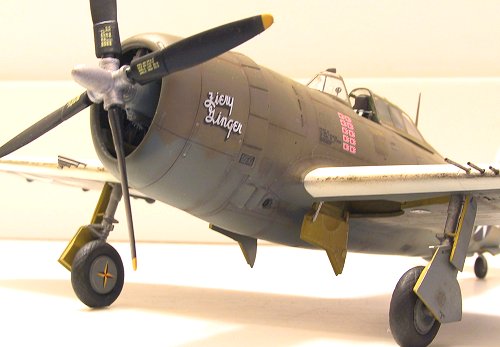
The rest of the build was smooth sailing. The surface detail on this kit is
beautiful. Other than the underside issue, the rest of this kit falls
together so well that none of the detail will be damaged with filler or
sanding. Hasegawa did make one error that I had read about in an earlier
review here on MM. Both ailerons have engraved trim tabs on the kit. Only
the left one should have this, and the right aileron should have a small
fixed, extended trim tab. I filled the engraved lines on the right aileron,
and added a small extension out of sheet plastic. One of the easiest fixes
yet! One other error which I didn't catch until too late regards the
windshield. Early P-47s had an additional brace running at around a 45
degree angle on each side of the windscreen. This extra framing is clearly
visible in photos, but I missed it until after my model was complete.
After painting the little details went on pretty quickly. I like the way
Hasegawa molds at least 1/2 of the wheels separate from the tires, making
painting very easy. The tire tread is well-done, and after joining the tire
halves together and sanding down the seam, it was easy to rescribe the lost
detail, I slightly flattened the tires to give the impression of the
massive weight of the P-47. After the landing gear was mounted, I added
hydraulic lines out of copper wire.
I drilled out the openings on the pitot tube, as well as all eight gun
barrels. Lining all these up did take a little time. All the lights are
provided as clear parts (at least the covers are), but the little formation
lights on the underside of the wing are so tiny they might be better off
being created with drops of white glue or epoxy or some other clear liquid.
I used the kit parts and attached them with Future. I cut a small piece of
aluminum foil to use for the mirror attached on top of the windscreen. The
last bit was adding a stretched sprue antenna and I was done!
Having solved (at least to my satisfaction) markings issues, painting
was a relatively easy process. These early Thunderbolts had a wavy
demarcation line between the olive drab and gray. I used paper masks to keep
this pattern uniform. Made one set for the right-hand side, then used this
as a template for the left-hand side to keep things consistent. I used
Aeromaster Neutral Gray for the undersides. I used BluTak to hold the paper
masks off of the surface and keep a feathered edge between the colors.
Aeromaster faded Olive Drab was used topsides. I still have a stash of
these out of production paints, and think they are great. I sprayed Model
Master Flat White on top of the camouflage colors, as these markings were
done this way on the real a/c, and I wanted to be able to weather through to
the underlying paint in some areas. Yards of masking tape later, the white
was successfully applied. I had to go back a few times and retouch various
oversprays. Aeromaster Blue was used for the fin tip.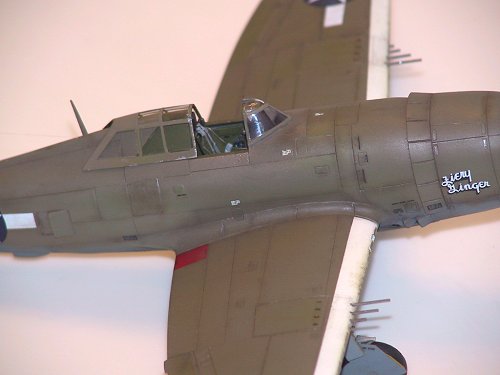
I was determined to use Future as my gloss coat, but have had minimal
success trying to spray it with my airbrush. I had read about the ease of
hand-brushing the stuff, and thought I would give it a shot. Worked like a
charm. I hand painted about 3 coats of Future over the entire model, and a
nice smooth gloss coat appeared. I was a little hesitant to try it, but
very happy I did so. It goes on a little thick, but the brush marks quickly
vanish and the entire coat slightly shrinks, so absolutely no detail is
hidden.
Most of the decals were from the Aeromaster sheet. Stenciling was from the
kit's decals. Every Hasegawa kit seems to have different quality decals.
These were rather thick, but with enough setting solution (and plenty of
gloss coat underneath) they worked out ok. Were I to do it again, I might
try and pick up an aftermarket stencil set (I think Aeromaster used to make
one). The black tail numbers were from an ancient HIS-AIR-DEC sheet I have
had forever.
I sealed everything with one more hand painted coat of Future, followed a
day later by a couple of coats of Testor's dullcoat in the spray can.
For weathering I primarily used pastels. The Pacific theater was
particularly brutal on paint and airframes. US paint tended to hold
considerably better than that used by the Japanese, but it still got pretty
beat up. I used dark brown and gray pastels to highlight panel lines, and
some different green shades to change the tones on the flying surfaces and
some panels. A watercolor black wash was used to highlight some panels and
openings. Black and gray pastels were used for exhaust staining. I used a
silver colored pencil, as well as Testor's aluminum to chip away at the
paint a bit. Further chipping was done using olive drab along the leading
edge of the wing.
Hasegawa makes a great P-47. There are some tiny corrections to make, but it
certainly looks the part. I spent much more time researching markings than I
did with the build. I definitely plan on building another at some point.
Bell, Dana, Air Force Colors, Vol. 3: Pacific and Home Front, 1942-47,
Squadron Signal Publications, 1997.
Famous Airplanes of the World No. 37, Burindo Co. Ltd., 1992.
Stafford, Gene B., Aces of the Southwest Pacific, Squadron Signal
Publications, 1977.
Stanaway, John C., Kearby's Thunderbolts: The 348th Fighter Group in World
War II, Schiffer Publishing, Ltd. 1997.
Stanaway, John, Mustang and Thunderbolt Aces of the Pacific and CBI,
Osprey Publishing Ltd., 1999,
Stanaway, John, "Fiery Ginger: Colonel Neel Kearby's Thunderbolts," in Fine
Scale Modeler, November 1999.
If you would like your product reviewed fairly and quickly by a
site that has well over 100,000 visitors a month, please contact
me or see other details in the Note to
Contributors.
Back to Main Page
Back to Reviews Page


 One major problem with the 'priority' situation, was that most additional fuel
drop tanks went to Europe, in spite of the greater distance problems in the
Pacific. Kenney's improvisational skills filtered down through the ranks, and
in Brisbane, Australia USAAF repair squadrons developed their own belly tank
capable of carrying 200 extra gallons of fuel. As a note here - this tank is
decidedly different than the tanks carried in Europe, and Hasegawa only
provides the European 'standard' tank in it's kits. So this is unusable for
most Pacific-flown P-47s.
One major problem with the 'priority' situation, was that most additional fuel
drop tanks went to Europe, in spite of the greater distance problems in the
Pacific. Kenney's improvisational skills filtered down through the ranks, and
in Brisbane, Australia USAAF repair squadrons developed their own belly tank
capable of carrying 200 extra gallons of fuel. As a note here - this tank is
decidedly different than the tanks carried in Europe, and Hasegawa only
provides the European 'standard' tank in it's kits. So this is unusable for
most Pacific-flown P-47s. In the first few combat engagements, P-47 pilots attempted to dogfight with
the enemy, and predictably losses were high for the Americans. This
reinforced views of the superiority of the P-38 (or rather the inferiority of
the P-47), but Kearby insisted it was a matter of proper training and
discipline to wring out the better characteristics of the P-47. He continued
on p.r. tours around the region, demonstrating his slashing attack ideas.
Kearby eventually proved his technique, downing his first two Japanese
aircraft on September 4th, 1943. Quickly the tactics were becoming more and
more successful, and by October the group was beginning to shoot down more and
more aircraft, culminating in a historic action on the 11th of that month.
In the first few combat engagements, P-47 pilots attempted to dogfight with
the enemy, and predictably losses were high for the Americans. This
reinforced views of the superiority of the P-38 (or rather the inferiority of
the P-47), but Kearby insisted it was a matter of proper training and
discipline to wring out the better characteristics of the P-47. He continued
on p.r. tours around the region, demonstrating his slashing attack ideas.
Kearby eventually proved his technique, downing his first two Japanese
aircraft on September 4th, 1943. Quickly the tactics were becoming more and
more successful, and by October the group was beginning to shoot down more and
more aircraft, culminating in a historic action on the 11th of that month. 
 I had almost been ready to use the 'barred' national insignia, combined with
12 victory flags, and a full white tail (as per the Aeromaster sheet which
should have been a warning in and of itself!!). The national insignia/flag
combo had to be right, as Kearby did not score this many victories until
October of 1943. By this time the bar had been on the insignia officially
for several months. So Aeromaster's combination of insignia and victories
was correct, or at least plausible. Hasegawa's might have been correct as
well, but I tend to think the bar was already added to the national markings
by the time any victory markings were applied (Kearby's first victory was
Sep. 4th, 1943). Most of this issue was therefore solved.
I had almost been ready to use the 'barred' national insignia, combined with
12 victory flags, and a full white tail (as per the Aeromaster sheet which
should have been a warning in and of itself!!). The national insignia/flag
combo had to be right, as Kearby did not score this many victories until
October of 1943. By this time the bar had been on the insignia officially
for several months. So Aeromaster's combination of insignia and victories
was correct, or at least plausible. Hasegawa's might have been correct as
well, but I tend to think the bar was already added to the national markings
by the time any victory markings were applied (Kearby's first victory was
Sep. 4th, 1943). Most of this issue was therefore solved. The rest of the build was smooth sailing. The surface detail on this kit is
beautiful. Other than the underside issue, the rest of this kit falls
together so well that none of the detail will be damaged with filler or
sanding. Hasegawa did make one error that I had read about in an earlier
review here on MM. Both ailerons have engraved trim tabs on the kit. Only
the left one should have this, and the right aileron should have a small
fixed, extended trim tab. I filled the engraved lines on the right aileron,
and added a small extension out of sheet plastic. One of the easiest fixes
yet! One other error which I didn't catch until too late regards the
windshield. Early P-47s had an additional brace running at around a 45
degree angle on each side of the windscreen. This extra framing is clearly
visible in photos, but I missed it until after my model was complete.
The rest of the build was smooth sailing. The surface detail on this kit is
beautiful. Other than the underside issue, the rest of this kit falls
together so well that none of the detail will be damaged with filler or
sanding. Hasegawa did make one error that I had read about in an earlier
review here on MM. Both ailerons have engraved trim tabs on the kit. Only
the left one should have this, and the right aileron should have a small
fixed, extended trim tab. I filled the engraved lines on the right aileron,
and added a small extension out of sheet plastic. One of the easiest fixes
yet! One other error which I didn't catch until too late regards the
windshield. Early P-47s had an additional brace running at around a 45
degree angle on each side of the windscreen. This extra framing is clearly
visible in photos, but I missed it until after my model was complete.